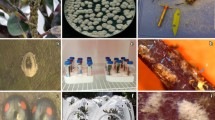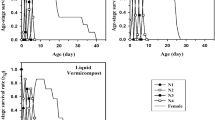Abstract
Verticillium lecanii (Fungi: Deuteromycete) blastospores were applied to a chrysanthemum crop by an ULV electrostatically charged rotary atomiser (APE-80). The deposition of spores and subsequent control ofAphis gossypii were compared to high volume hydraulic application. A full rate treatment (2×1013 blastospores per ha.) was applied by the APE-80 at week 1 and reduced spore rates of 1/6th and 1/12th applied by both the APE-80 and the hydraulic sprayer once and twice a week respectively for weeks 1 to 6. Untreated plots served as controls.
Initial deposits of spores were higher with the electrostatic sprayer and better distributed with respect to the position of the target aphids. Significantly lower aphid populations were recorded on the electrostatically treated plots in week 4. The single full rate treatment had significantly fewer aphids than the untreated plots from week 3 and all treatments had significantly fewer aphids than the untreated plots from week 5 onwards. The proportion of the aphid population killed byV. lecanii was higher on the electrostatically treated plots until week 6.
Résumé
Les blastospores deVerticillium lecanii (Fungi: Deuteromycètes) ont été répandues sur une culture de chrysanthèmes au moyen d'un atomiseur électrostatique à très bas volume (APE-80). Le dépôt de spores et la réduction des populations d'A. gossypii qui s'en suivit furent comparés avec ceux d'une application hydraulique à grand volume. Un traitement à dose complète (soit 2×1013 blastospores/ha) fut appliqué au moyen de l'atomiseur AEP-80 la semaine 1 et des doses réduites de spores de 1/6 et de 1/12 furent appliquées au moyen à la fois de l'atomiseur et du pulvérisateur une fois et 2 fois par semaine respectivement, des semaines 1 à 6. Des parcelles non traitées servaient de témoins.
Les dépôts initiaux de spores furent plus importants avec l'atomiseur électrostatique et mieux distribués par rapport à la disposition des aphides cibles. Des populations de pucerons moindres furent enregistrées dans les parcelles traitées électrostatiquement durant la semaine 4. Le simple traitement à dose complète a significativement moins de pucerons que les parcelles non traitées depuis la semaine 5. La proportion de la population de pucerons tués parV. lecanii était plus importante dans les parcelles traitées électrostatiquement jusqu'à la semaine 6.
Similar content being viewed by others
References
Adams, A. J. &Palmer, A. — 1986. Deposition patterns of small droplets applied to a tomato crop using the Ulvafan and two prototype electrostatic sprayers. —Crop Protection, 5, 358–364.
Arnold, A. J. & Pye, B. J. — 1980. Spray application with charged rotary atomisers. —BCPC Applic. Symp., Spraying systems for the 1980s, 109–117.
Cayley, G. R., Etheridge, P., Griffiths, D. C., Phillipps, F. T., Pye, B. J. &Scott, G. C. — 1984. A review of the performance of electrostatically charged rotary atomisers on different crops. —Ann. Appl. Biol., 105, 379–386.
Cayley, G. R., Griffiths, D. C., Lewthwaite, R., Pye, B. J., Dewar, A. M. &Winder, G. L. — 1987. Comparison of application methods for aphicides on sugar beet and swedes. —Crop Protection, 6, 365–370;
Dick, K. M. — 1981. Studies on the low volume application of the entomophagous fungusVerticillium lecanii. — M.Sc. thesis, University of London.
Hall, R. A. &Burges, H. D. — 1979. Control of aphids in glasshouses with the fungus,Verticillium lecanii. —Ann. Appl. Biol., 93, 235–246.
Hall, R. A. &Papierok, B. — 1982. Fungi as biological control agents of arthropods of agricultural and medical importance. —Parasitology, 84, 205–240.
Helyer, N. L. & Wardlow, L. R. — 1987. Aphid control of chrysanthemum using frequent, low dose applications ofVerticillium lecanii — Bull. SROP/WPRS 1987/X/2 62–65.
Law, S. E. &Mills, H. A. — 1980. Electrostatic application of low-volume microbial insecticide spray on broccoli plants. —J. Amer. Soc. Hortic. Sci., 105, 774–777.
Law, S. E. &Lane, M. D. — 1981. Electrostatic deposition of pesticide spray onto foliar targets of varying morphology. —Trans. Amer. Soc. Agric. Eng., 24, 1441–1448.
Matthews, G. A. — 1975. Determination of droplet size. —Pans, 21, 213–225.
Matthews, G. A. — 1979. Pesticide application methods. —Longman, London.
Milner, R. J. &Lutton, G. C. — 1986. Dependence ofVerticillium lecanii [Fungi: Hyphomycetes] on high humidities for infection and sporulation usingMyzus persicae [Homoptera: Aphididae] as host. —Environ. Entomol., 15, 380–382.
Richards, M. G. — 1984. The use of a granulosis virus for control of codling moth,Cydia pomonella; application methods and field persistence. —Unpublished Ph. D. thesis, Imperial College, University of London.
Smith, D. B. & Bouse, L. F. — 1981. Machinery and factors that affect the application of pathogens. — In: Microbial control of pests and plant diseases 1970–1980, (H. D. Burges, ed.) —Academic, London, 635–653.
Smith, D. B., Hostetter, D. L. &Ignoffo, C. M. — 1977. Ground spray equipment for applyingBacillus thuringiensis suspensions on soybeans. —J. Econ. Entomol., 70, 633–637.
Author information
Authors and Affiliations
Rights and permissions
About this article
Cite this article
Sopp, P.I., Gillespie, A.T. & Palmer, A. Application ofVerticillium lecanii for the control ofAphis gossypii by a low-volume electrostatic rotary atomiser and a high-volume hydraulic sprayer. Entomophaga 34, 417–428 (1989). https://doi.org/10.1007/BF02372481
Received:
Accepted:
Issue Date:
DOI: https://doi.org/10.1007/BF02372481




